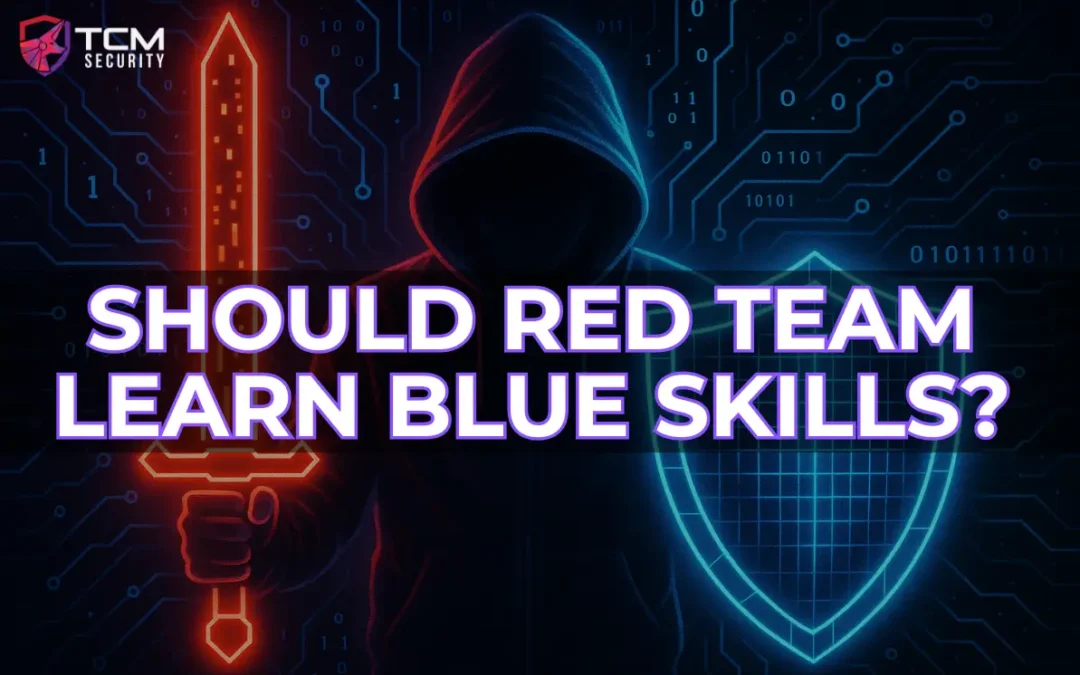In cybersecurity, we often divide professionals into two camps: Red Teamers (the attackers) and Blue Teamers (the defenders). Red Teams simulate real-world attacks to expose weaknesses, while Blue Teams focus on monitoring, detection, and response.
These can seem like adversarial roles, and there is an amount of good-natured competition. Red team trying to slip by defenses. Blue team trying to confound attackers. But ultimately, everyone is working toward the same goal: Protecting.
As an ethical hacker, you can advance your skills and ultimately increase your value to clients by gaining a deeper understanding of the defensive side of the field. By learning how the blue team thinks and operates, offensive specialists can sharpen their craft, improve collaboration, and even expand career opportunities. Let’s break down why.
More Effective Pentesting
Having your own methodologies down and the skill to execute them is a primary step in offensive security, but knowing the tactics of the blue team advances your pentesting potency. When you know how defenders monitor systems, analyze logs, and tune their SIEMs, you can design more realistic and challenging attacks. For example:
- If you understand how endpoint detection and response (EDR) tools trigger alerts, you can take steps to better evade detection.
- Knowing common incident response playbooks helps you test whether Blue Teams can actually catch and contain your actions in time.
Instead of just “breaking in,” you’re testing the defense where it matters most.
Reading the “Adversary’s” Playbook
Every Blue Team has methodologies and protocols, from MITRE ATT&CK mappings to escalation procedures. By studying these, Red Teamers can camouflage their activities and more closely simulate the workarounds that threat actors may use in the wild.
For instance, if you know that a SOC analyst prioritizes privilege escalation alerts over low-level reconnaissance alerts, you can adjust your attack methodology to stay under the radar longer.
Understanding the playbook makes you a smarter adversary and a better teacher when you deliver findings back to the client.
Exposure to Different Mindsets
Cybersecurity isn’t just about tools, but about how people think. While the offensive and defensive sides are both trying to secure organizations against vulnerabilities, different traits are present in the individual teams.
Red Team: adaptability, creativity, problem-solving under constraints.
Blue Team: anticipation, pattern recognition, proactive prevention.
By experiencing both, you sharpen your overall strategic thinking. Instead of a one-sided view, you gain a holistic perspective on how attacks unfold and how defenses can (or should) respond or preempt.
Better Collaboration: Enter the Purple Team
Security is not Red vs. Blue. The real win is when both teams collaborate. That’s where Purple Teaming comes in.
As an offensive security professional, you’ll often work with defenders during or after an engagement. If you understand their tools and challenges, communication becomes smoother. Instead of handing over a list of vulnerabilities, you’re providing actionable insights that make defenses stronger.
The result? Faster feedback, stronger trust, a more secure organization, and a better reputation for you.
Understanding the Client: Communication and Reporting
While it is not as exciting as being a 1337 hacker, knowing the concerns and priorities of the client, and their security team, is very important if you want glowing recommendations during your pentesting career.
A portion of offensive security involves technical skills, and while that is the impressive part that red teamers like to improve and show off, having the skill to write a clear report that addresses an organization’s needs is what the client brags about… to other potential clients. Having a better understanding of what the blue team cares about will help you immensely in this process.
Makes You More Versatile in Your Career
The industry is full of professionals who have moved from Red to Blue or Blue to Red. Having skills on both sides makes you more marketable and opens up new career paths. This can also help alleviate burnout by introducing new perspectives, challenges, and goals while remaining in the field of cybersecurity.
Employers want specialists who can think offensively and defensively. Whether you want to stay in Red Teaming, shift into incident response, or even move into leadership, knowing both sides gives you flexibility and credibility.
Training Options to Get Started
If you want to expand your skills on either front, here are some practical training paths and hands-on certifications offered by TCM.
Red Team:
Practical Ethical Hacker (PEH) course – hands-on penetration testing fundamentals.
Practical Junior Penetration Tester (PJPT) certification – the experience of conducting an internal penetration test.
Blue Team:
SOC 101 course – introduction to monitoring, detection, analysis, and defense operations.
Practical Security Analyst Associate (PSAA) certification – tests blue team skills against real-world SOC analyst duties.
Building knowledge on both sides doesn’t just improve your technical skills; it makes you a more well-rounded professional. For a deeper dive into TCM’s offerings in training and certification, take a look at our Pentester Roadmap and our SOC Analyst Roadmap.
Final Thoughts
At the end of the day, cybersecurity isn’t about winning as Red or Blue, it’s about securing the organization. Data breaches, ransomware, DoS attacks – these are harmful and affect a lot of people, disrupting our lives at least and causing real damage in some cases. Red teamers have a responsibility to provide the best service they can, and knowing how defenders think makes you a better attacker.
Investing in Blue Team skills provides sharper offensive capabilities, stronger collaboration with defenders, and more career opportunities. Learn the other side, and you’ll be more effective in your role and more valuable to the teams you work with.
About the Author: Josh Daniels
Josh is an avid storyteller and writer who loves learning about the behind-the-scenes of the digital world we live in. While his professional experience is in content marketing, Josh began pursuing a career in cybersecurity in 2022, gaining a Sec+ certificate along with other training from industry professionals and a life long learner attitude.
When he is not writing, Josh enjoys outdoor adventures with his family, watching movies, reading, and an unofficial (unpaid) side gig as a Game Master Consultant for several friends who play table top RPGs. At TCM, Josh has found a home where his passion for storytelling and cybersecurity meet.
“Once men turned their thinking over to machines in the hope that this would set them free. But that only permitted other men with machines to enslave them.”
– Frank Herbert
About TCM Security
TCM Security is a veteran-owned, cybersecurity services and education company founded in Charlotte, NC. Our services division has the mission of protecting people, sensitive data, and systems. With decades of combined experience, thousands of hours of practice, and core values from our time in service, we use our skill set to secure your environment. The TCM Security Academy is an educational platform dedicated to providing affordable, top-notch cybersecurity training to our individual students and corporate clients including both self-paced and instructor-led online courses as well as custom training solutions. We also provide several vendor-agnostic, practical hands-on certification exams to ensure proven job-ready skills to prospective employers. Pentest Services: https://tcm-sec.com/our-services/ Follow Us: Email List | LinkedIn | YouTube | Twitter | Facebook | Instagram | TikTok
Contact Us: [email protected]
See How We Can Secure Your Assets
Let’s talk about how TCM Security can solve your cybersecurity needs. Give us a call, send us an e-mail, or fill out the contact form below to get started.

